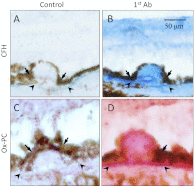Complement factor H genotypes impact risk of age-related macular degeneration by interaction with oxidized phospholipids
- PMID: 22875704
- PMCID: PMC3427125
- DOI: 10.1073/pnas.1121309109
Complement factor H genotypes impact risk of age-related macular degeneration by interaction with oxidized phospholipids
Abstract
The rs1061170T/C variant encoding the Y402H change in complement factor H (CFH) has been identified by genome-wide association studies as being significantly associated with age-related macular degeneration (AMD). However, the precise mechanism by which this CFH variant impacts the risk of AMD remains largely unknown. Oxidative stress plays an important role in many aging diseases, including cardiovascular disease and AMD. A large amount of oxidized phospholipids (oxPLs) are generated in the eye because of sunlight exposure and high oxygen content. OxPLs bind to the retinal pigment epithelium and macrophages and strongly activate downstream inflammatory cascades. We hypothesize that CFH may impact the risk of AMD by modulating oxidative stress. Here we demonstrate that CFH binds to oxPLs. The CFH 402Y variant of the protective rs1061170 genotype binds oxPLs with a higher affinity and exhibits a stronger inhibitory effect on the binding of oxPLs to retinal pigment epithelium and macrophages. In addition, plasma from non-AMD subjects with the protective genotype has a lower level of systemic oxidative stress measured by oxPLs per apolipoprotein B (oxPLs/apoB). We also show that oxPL stimulation increases expression of genes involved in macrophage infiltration, inflammation, and neovascularization in the eye. OxPLs colocalize with CFH in drusen in the human AMD eye. Subretinal injection of oxPLs induces choroidal neovascularization in mice. In addition, we show that the CFH risk allele confers higher complement activation and cell lysis activity. Together, these findings suggest that CFH influences AMD risk by modulating oxidative stress, inflammation, and abnormal angiogenesis.
Conflict of interest statement
The authors declare no conflict of interest.
Figures




References
Publication types
MeSH terms
Substances
Grants and funding
LinkOut - more resources
Full Text Sources
Other Literature Sources
Medical
Molecular Biology Databases
Miscellaneous

